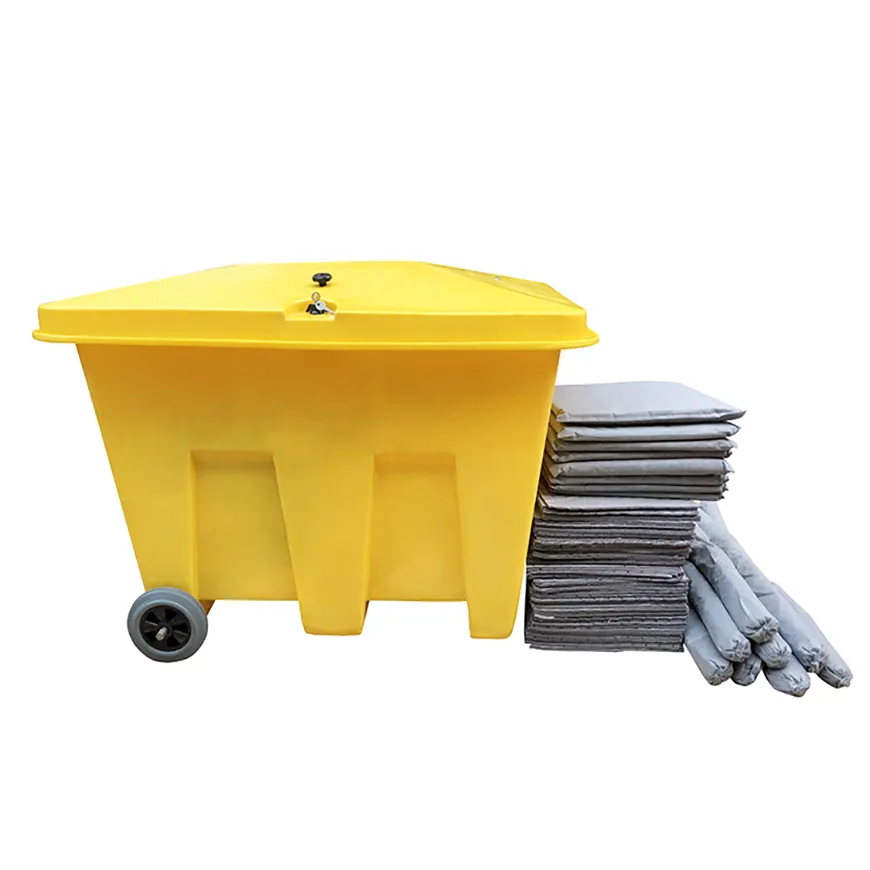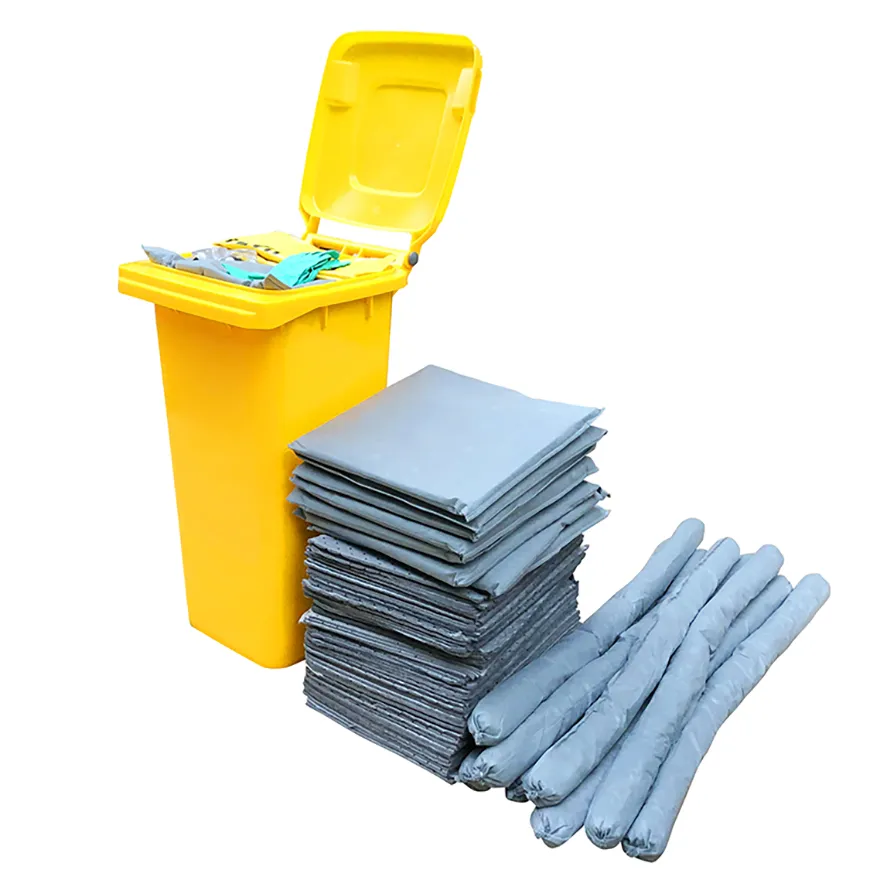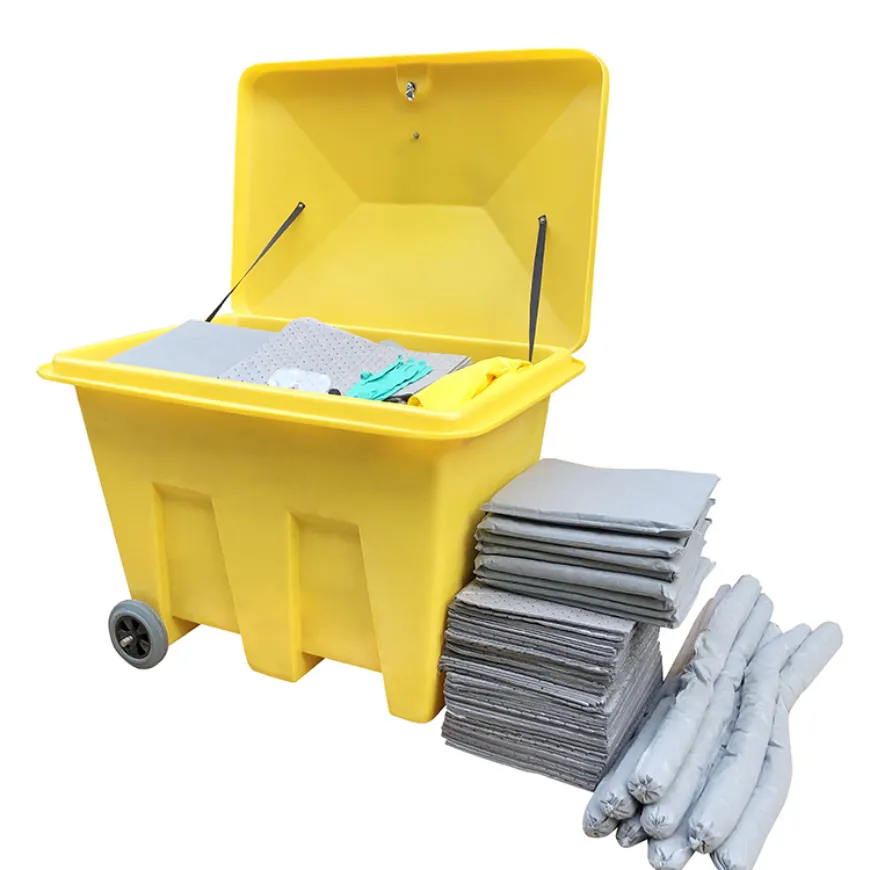
Imagine a chemical spill in your workplace. Without the right tools, it could harm people, damage the environment, and even disrupt your operations. That’s where a hazardous material spill kit comes in. It’s a collection of essential tools designed to help you safely manage and clean up hazardous spills. These kits are crucial if you work with chemicals, oils, or other dangerous substances.
When spills aren’t handled properly, the consequences can be severe. Hazardous materials can seep into the soil, harming plants and contaminating underground water. They can also affect wildlife, causing mutations or diseases. In humans, exposure to toxins like mercury or lead can lead to serious health issues, including cancer. A spill kit helps you prevent these risks, keeping your workplace and the environment safe.
Key Takeaways
A hazardous material spill kit helps clean up chemical spills safely. It has tools and gear to protect people and nature.
Learning how to use a spill kit is very important. Workers should know how to check spills, use absorbents, and throw waste away properly.
Keep spill kits stored well and in good condition. Check them often and replace anything used right away.
There are different spill kits for different needs. Pick the right one for what you work with, like universal, oil-only, or chemical kits.
Follow rules for getting rid of hazardous waste. Label waste bags clearly and throw them away the right way to keep the environment safe.
What is a Hazardous Material Spill Kit?
Definition and Purpose
A hazardous material spill kit is your first line of defense when dealing with spills involving dangerous substances. It’s a carefully organized set of tools designed to help you respond quickly and safely to leaks or spills of hazardous materials like acids, oils, or flammable liquids. These kits are built to handle a wide range of hazardous substances, offering broad chemical compatibility. Whether you’re dealing with solvents, pesticides, or paints, a spill kit ensures you can neutralize the threat before it spreads.
What makes these kits so effective? They come equipped with heavy-duty personal protective equipment (PPE) like gloves, goggles, and aprons to keep you safe. Some even include respirators for added protection. You’ll also find vapor barriers and sealing agents to block harmful vapors, making it easier to contain the spill. By having a spill kit on hand, you’re not just cleaning up a mess—you’re protecting yourself, your coworkers, and the environment.
Importance in Hazardous Environments
If you work in a hazardous environment, having a spill kit isn’t just a good idea—it’s often a legal requirement. Industries like manufacturing, automotive maintenance, and laboratories rely on these kits to manage the risks associated with hazardous materials. For example, automotive shops need them for oil or battery acid spills, while laboratories use them to handle biohazards and chemical leaks.
Spill kits are essential in places like transportation fleets, loading docks, and fuel stations, where spills can happen during loading or dispensing. They help you contain and clean up spills quickly, preventing hazardous substances from spreading to other areas. This not only protects the environment but also ensures compliance with safety regulations like OSHA’s General Duty Clause and HAZWOPER standards.
By keeping a spill kit readily available, you’re prioritizing chemical safety and creating a safer workplace for everyone.
Components of a Hazardous Material Spill Kit

Absorbent Materials
Absorbent materials are the backbone of any spill kit. They’re designed to soak up hazardous liquids quickly and efficiently, helping you control the spill before it spreads. These materials come in different forms, each tailored to specific situations:
Absorbent Pads: These are perfect for soaking up liquids without dripping. They’re often designed for specific types of spills, like oil or chemicals.
Absorbent Socks: These act as barriers, blocking spills and stopping liquids from flowing under surfaces or into drains.
Other Absorbent Materials: Some kits include absorbent bags or jars, which are great for handling unique spill types.
By using the right absorbent materials, you can minimize the damage and make cleanup much easier.
Personal Protective Equipment (PPE)
Your safety comes first when dealing with hazardous spills. That’s why every spill kit includes personal protective equipment (PPE). These items shield you from harmful substances while you manage the spill. Here’s a quick look at the safety standards for PPE:
Safety Standard | Description |
|---|---|
All PPE must meet safety and quality benchmarks appropriate for the hazards encountered. | |
Tailored PPE | Each spill kit must include PPE tailored to the specific substances handled in the workplace. |
Accessibility | PPE should be stored with or near spill kits and provided in a range of sizes to fit all employees. |
From gloves and goggles to aprons and respirators, PPE ensures you stay protected while handling dangerous materials.
Containment and Cleanup Tools
Containment and cleanup tools are essential for managing spills effectively. These tools help you stop the spill from spreading and safely dispose of the waste. Common items you’ll find in a spill kit include:
Absorbent Pads and Socks: These help soak up and block spills.
Disposable Bags: Use these to safely discard used cleaning materials.
Safety Goggles and Gloves: Protect your eyes and hands from hazardous substances.
Disposal Containers: These hold all the items you’ve used during cleanup.
With these tools, you can tackle spills confidently and keep your workplace safe.
Disposal Bags and Containers
Disposal bags and containers are essential parts of any hazardous material spill kit. They help you safely collect and store contaminated materials after a spill. Without them, you risk spreading the hazardous substance further or exposing others to danger.
The disposal bags included in spill kits are designed to handle hazardous waste. They’re made from durable materials that resist tearing and leakage. You can use these bags to collect absorbent pads, gloves, and other contaminated items. Once filled, you should seal the bags tightly to prevent any leaks. Each bag must also be clearly labeled as hazardous waste. This labeling ensures that anyone handling the bag knows what’s inside and how to dispose of it properly.
Containers in spill kits often serve as a secondary layer of protection. They’re used to store the sealed waste bags and keep everything secure until disposal. Following local regulations for hazardous waste disposal is crucial. These rules guide you on where and how to dispose of the waste safely, protecting both people and the environment.
Tip: Always double-check that your disposal bags and containers are in good condition before using them. A damaged bag or container can lead to leaks and additional cleanup.
By using the right disposal tools, you can manage hazardous waste effectively and reduce the risks associated with spills.
Instruction Manuals
Instruction manuals are your go-to guides when using a spill kit. They provide clear, step-by-step instructions to help you handle spills quickly and safely. Even if you’ve never used a spill kit before, these manuals make the process straightforward.
Here’s what you’ll typically find in a spill kit manual:
A list of personal protective equipment (PPE) included in the kit, such as gloves, goggles, and coveralls.
Instructions for using containment tools like booms or barriers to stop the spill from spreading.
Details on sealing and disposing of hazardous waste using the provided bags and ties.
Guides for using absorbent materials to neutralize or soak up the spill.
A step-by-step process for managing the spill, from assessment to cleanup and disposal.
These manuals are written to be easy to follow, even in high-pressure situations. They ensure you don’t miss any critical steps during the cleanup process. Keeping the manual accessible and reviewing it regularly can help you stay prepared for emergencies.
Note: If your workplace handles multiple types of hazardous materials, make sure the instruction manual covers all relevant scenarios. This ensures you’re ready for any kind of spill.
With a well-written manual, you’ll feel confident and equipped to handle spills effectively.
How Does a Spill Kit Work?

Assessing the Spill
When a hazardous chemical spill occurs, the first thing you need to do is assess the situation. This step helps you understand the risks and decide how to proceed. Here’s a simple process to follow:
Evaluate the Risks: Look at the potential dangers. Could the spill harm people, damage property, or impact the environment?
Evaluate Quantities: Check how much of the material has spilled. If it’s a small amount, you can likely handle it with your spill kit. For larger spills, you might need professional help.
By taking these steps, you can determine the severity of the spill and ensure everyone stays safe. Always prioritize your safety and use personal protective equipment (PPE) before getting closer to the spill.
Containing the Spill
Once you’ve assessed the spill, your next move is containment. This step stops the hazardous material from spreading further. You can use several methods to contain spills effectively:
Method | Description |
|---|---|
These tools let you apply spill control agents from a safe distance, keeping you away from direct contact with the hazardous material. | |
Solidification Agents | These create barriers that slow or stop the spread of the spill. They also solidify liquids, making them easier to handle during cleanup. |
Vapor Suppression Agents | For volatile spills, these agents reduce harmful vapors quickly, allowing for safer handling and cleanup. |
You can also use absorbent pads for liquid spills or deploy chemical booms to block the spread. Mark off the area around the spill to keep others away. Containment is crucial for minimizing damage and making the spill cleanup process more manageable.
Neutralizing or Absorbing the Hazardous Material
After containing the spill, it’s time to neutralize or absorb the hazardous material. This step ensures the spill is no longer a threat. Your spill kit will include absorbent materials like pads, socks, or powders designed for this purpose. For example, absorbent pads work well for soaking up liquids, while drying agents can help with spills that need solidification.
If the spill involves chemicals, you might need neutralizing agents. These substances react with the hazardous material to make it safer to handle. Always follow the instructions in your spill kit manual to use these materials correctly. Once the spill is neutralized or absorbed, you can move on to the final stages of cleanup and disposal.
Tip: Always double-check that the absorbent or neutralizing agents in your spill kit are compatible with the hazardous chemical spill you’re dealing with. Using the wrong materials can make the situation worse.
By following these steps, you can handle spills safely and efficiently, protecting both people and the environment.
Cleaning Up and Disposing of Waste
Once you’ve contained and neutralized the spill, it’s time to focus on the cleanup and disposal process. This step ensures that no residual hazards remain and that all waste is handled safely. Here’s how you can do it effectively:
Collect Contaminated Materials: Use the waste disposal bags from your spill kit to gather all contaminated items, including absorbent materials, used personal protective equipment (PPE), and any solidified residues. Seal the bags tightly to prevent leaks.
Label the Waste: Clearly mark each bag as hazardous waste. Include details like the type of material and the proper disposal procedure. This step ensures compliance with hazardous waste regulations.
Follow Local Disposal Guidelines: Check your local environmental laws to determine the correct way to dispose of hazardous materials. Improper disposal can lead to fines or environmental damage.
Decontaminate the Area: After removing the waste, clean the affected area thoroughly. Use appropriate cleaning agents to eliminate any remaining traces of the spill. Inspect the site to ensure no hazards are left behind.
Dispose of PPE Properly: Don’t forget to discard your used gloves, goggles, and other PPE in the designated disposal bags. Treat them as hazardous waste since they’ve been exposed to dangerous substances.
Tip: Always wear PPE during the cleanup process and avoid rushing. Taking your time reduces the risk of accidents and ensures a thorough job.
By following these steps, you can complete the spill cleanup process safely and responsibly, protecting both people and the environment.
Reporting and Documenting the Incident
After handling the spill, you need to report and document the incident. This step is crucial for compliance with safety regulations and for preventing similar accidents in the future. Here’s what to include in your report:
Basic Information: Provide your name, location, and contact details. Include the name and address of the party responsible for the spill.
Incident Details: Record the date, time, and exact location of the spill. Describe the source and cause of the release, as well as the type and quantity of materials involved.
Impact Assessment: Note the medium affected (e.g., land or water), any injuries or fatalities, and the potential danger posed by the spill. Mention if an evacuation occurred and the weather conditions at the time.
Notifications: List any agencies you contacted, such as local environmental authorities or emergency services.
Callout: If the spill involved hazardous chemicals, include information from the container’s label or the material safety data sheet (MSDS). This might include hazard ratings or specific handling instructions.
Accurate documentation helps you stay compliant with regulations and provides valuable insights for improving your spill response procedures. It’s not just about meeting legal requirements—it’s about creating a safer workplace for everyone.
Types of Spill Kits and Their Uses

When it comes to managing spills, not all spill kits are created equal. Each type is designed for specific scenarios, so choosing the right one is essential. Let’s explore the most common types and how they work.
Universal Spill Kits
Universal spill kits are the jack-of-all-trades. They’re designed to handle almost any liquid, whether it’s water-based, oil-based, or even mild chemicals. This versatility makes them ideal for workplaces with mixed environments where different types of spills might occur.
Here’s how universal spill kits compare to other types:
Feature | Universal Spill Kits | Oil Spill Kits | Chemical Spill Kits |
|---|---|---|---|
Versatility | Absorbs almost any liquid | Absorbs petroleum and hydrocarbons | Absorbs hazardous chemicals |
Cost-Effectiveness | Generally more affordable | More expensive due to specialization | Higher cost due to specialized materials |
Specific Use Cases | Suitable for mixed environments | Used in environments with oil spills | Used in environments with chemical spills |
If your workplace deals with a variety of substances, a universal spill kit is a cost-effective and practical choice.
Oil-Only Spill Kits
Oil-only spill kits are specialists. They’re designed to absorb oil and other hydrocarbons without soaking up water. This makes them perfect for outdoor environments or areas near water sources, like marinas or construction sites.
These kits include hydrophobic materials like absorbent pads, socks, and booms. They repel water while attracting oil, making cleanup efficient. For example, if oil spills into a pond, you can use these materials to remove the oil without disturbing the water. Their buoyant nature ensures they stay afloat, even when fully saturated.
If you work in industries like shipping or automotive repair, having an oil-only spill kit on hand is a must.
Chemical Spill Kits
Chemical spill kits are your go-to for hazardous spills. They’re specifically designed to handle dangerous chemicals, including acids, solvents, and other reactive substances. These kits contain specialized absorbents that neutralize or safely contain the chemicals, reducing risks to you and the environment.
Unlike oil-only kits, chemical spill kits can handle a broader range of substances. This makes them essential for laboratories, manufacturing plants, or any workplace dealing with hazardous materials. Always check the compatibility of the kit with the chemicals you use to ensure safety.
If you’re handling hazardous substances regularly, a chemical spill kit is a critical investment for your safety and compliance.
Specialty Spill Kits
Not all spills are the same, and sometimes you need a kit designed for a specific job. That’s where specialty spill kits come in. These kits are tailored to handle unique situations, giving you the tools you need to tackle even the trickiest spills. Let’s take a closer look at some examples and how they can help.
Hazmat Spill Kits: These are your go-to for high-risk hazardous materials. They include heavy-duty personal protective equipment (PPE), vapor barriers, and absorbents designed for dangerous chemicals. If you work in environments with highly toxic substances, this kit is a must-have.
Biohazard Spill Kits: Perfect for healthcare settings, these kits help you safely clean up blood, bodily fluids, or other biohazards. They often include biohazard disposal bags, disinfectants, and sharps containers to handle needles or glass.
Battery-Acid Spill Kits: If you deal with battery maintenance, this kit is essential. It contains neutralizing agents specifically for acid spills, along with absorbent materials and PPE to keep you safe.
Mercury Spill Kits: Mercury spills are tricky because of the toxic vapors. These kits include mercury absorbents, vapor suppressors, and tools to safely collect and contain the mercury.
Marine Spill Kits: Designed for aquatic environments, these kits include floating absorbents and barriers to contain spills on water. They’re ideal for marinas, shipping docks, or any place near water.
Tip: Always choose a specialty spill kit that matches the materials you handle. Using the wrong kit can make cleanup harder and more dangerous.
Specialty spill kits give you confidence when dealing with unique hazards. By having the right tools on hand, you can respond quickly and effectively, keeping your workplace and the environment safe.
Tips for Proper Usage and Maintenance

Storing a Spill Kit
Where you store your spill kit matters. You want it to be easy to find and ready to use when an emergency strikes. Follow these simple guidelines to ensure your kit is always accessible:
Keep the kit in a visible spot. Bright colors and clear labels make it easy to identify.
Place it in an accessible location. Quick access can make all the difference during a spill response.
Train your team on where the kit is stored. Regular practice drills help everyone stay prepared.
Check the kit’s contents periodically. Make sure everything is in good condition and ready for use.
By following these safety guidelines, you’ll save precious time during a spill clean up and reduce potential hazards.
Regular Inspection and Maintenance
A spill kit is only useful if it’s in good shape. Regular inspections ensure your kit is ready when you need it. Here’s what you should do:
Inspect the kit every one to six months. The frequency depends on how often it’s used and whether it’s sealed or unsealed.
For sealed kits, check for tampering and inspect the contents at least once or twice a year.
Replace any damaged or expired items immediately. Missing or faulty components can compromise your spill response plan.
Staying on top of maintenance keeps your kit reliable and ensures compliance with chemical safety standards.
Training Employees
Even the best spill kit won’t help if your team doesn’t know how to use it. Spill kit training is essential for effective spill response. Here’s what your employees should learn:
The contents of the kit and the proper personal protective equipment for different hazards.
Techniques for decontaminating the area and disposing of spill debris.
How to segregate waste based on classification and label it for disposal.
First aid procedures for injuries or exposures caused by spills.
How to stop a spill from spreading and practice cleanup with mock spills.
Regular training ensures everyone knows what to do in an emergency. It also reinforces your workplace’s commitment to chemical safety.
Tip: Schedule refresher courses and hands-on practice sessions to keep skills sharp and your team confident.
Avoiding Common Mistakes
Using a spill kit effectively requires more than just having one on hand. Mistakes during a spill response can make the situation worse or put you at risk. Let’s go over some common errors and how you can avoid them.
Skipping the Assessment Step
Jumping straight into cleanup without assessing the spill is a big mistake. You need to evaluate the type and size of the spill first. This helps you decide if your spill kit is enough or if you need professional help. Always follow safety guidelines and wear personal protective equipment (PPE) before approaching the spill.Using the Wrong Spill Kit
Not all spill kits are the same. Using a universal kit for a chemical spill or an oil-only kit for hazardous materials can lead to ineffective cleanup. Make sure you’re using the right kit for the job. Check the labels and contents of your kit to ensure compatibility with the spilled substance.Improper Disposal of Waste
Tossing contaminated materials into regular trash bins is a serious error. Hazardous waste must be disposed of according to local guidelines. Use the disposal bags and containers provided in your kit, and label them clearly as hazardous waste.Neglecting Training
Even the best tools won’t help if you don’t know how to use them. Lack of training can lead to panic or improper handling during an emergency. Regularly review safety guidelines and practice spill response drills with your team.Failing to Restock the Kit
After using your spill kit, forgetting to replace used items can leave you unprepared for the next spill. Always inspect and restock your kit immediately after use.
Tip: Keep a checklist of your kit’s contents. This makes it easier to spot missing items during inspections.
By avoiding these mistakes, you’ll handle spills more effectively and ensure a safer workplace.
A hazardous material spill kit is more than just a collection of tools—it’s your safeguard against workplace hazards. By understanding its components and how to use it, you can handle spills confidently and protect both people and the environment. Proper training ensures your team knows how to respond effectively, from using absorbent materials to decontaminating areas. Accessible and well-maintained kits make all the difference during emergencies.
Using spill kits properly also benefits the environment. Spills can harm ecosystems and communities, but effective containment tools prevent further damage. Combining hands-on drills with online training builds confidence and ensures compliance with safety standards. When you prioritize preparation and maintenance, you create a safer workplace and contribute to environmental protection.
Remember: A well-prepared team and a reliable spill kit are your best defenses against hazardous materials.
FAQ
What should I do if my spill kit is missing items?
Check your kit regularly to ensure it’s fully stocked. If you notice missing items, replace them immediately. Keep a checklist of the kit’s contents to make restocking easier. A complete kit ensures you’re always ready to handle spills effectively.
Tip: Order replacement items in bulk to save time and money.
Can I use a spill kit for any type of spill?
Not all spill kits work for every spill. Universal kits handle most liquids, but oil-only kits repel water, and chemical kits are for hazardous substances. Always match the kit to the material spilled for safe and effective cleanup.
Reminder: Check your kit’s label to confirm compatibility.
How often should I inspect my spill kit?
Inspect your spill kit every 1-6 months, depending on usage. For sealed kits, check at least twice a year. Look for expired or damaged items and replace them promptly. Regular inspections keep your kit reliable during emergencies.
Do I need training to use a spill kit?
Yes, training is essential. It helps you understand how to use the kit’s tools, wear PPE, and follow cleanup procedures. Practice drills improve your confidence and ensure you’re ready to act quickly during a spill.
Pro Tip: Schedule annual refresher courses for your team.
What happens if I dispose of hazardous waste incorrectly?
Improper disposal can harm the environment and lead to fines or legal issues. Always follow local guidelines for hazardous waste disposal. Use the labeled bags and containers in your spill kit to safely store and transport waste.
Warning: Never mix hazardous waste with regular trash.
See Also
Evaluating UPQUARK Marine Absorbents for Oil Spill Management
A Comprehensive Resource on Oil-Only Absorbent Pillows

